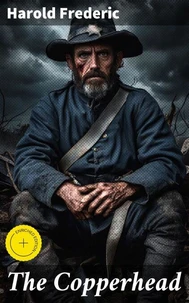The Copperhead
Par :Formats :
Disponible dans votre compte client Decitre ou Furet du Nord dès validation de votre commande. Le format ePub est :
- Compatible avec une lecture sur My Vivlio (smartphone, tablette, ordinateur)
- Compatible avec une lecture sur liseuses Vivlio
- Pour les liseuses autres que Vivlio, vous devez utiliser le logiciel Adobe Digital Edition. Non compatible avec la lecture sur les liseuses Kindle, Remarkable et Sony
 , qui est-ce ?
, qui est-ce ?Notre partenaire de plateforme de lecture numérique où vous retrouverez l'ensemble de vos ebooks gratuitement
Pour en savoir plus sur nos ebooks, consultez notre aide en ligne ici
- Nombre de pages168
- FormatePub
- ISBN978-3-8496-4935-7
- EAN9783849649357
- Date de parution23/06/2017
- Protection num.Digital Watermarking
- Taille235 Ko
- Infos supplémentairesepub
- ÉditeurJAZZYBEE VERLAG
Résumé
"The Copperhead" is a farmer in northern New York who sympathizes with the South in the anti-slavery struggle, and who in consequence is boycotted by his neighbors. He is driven from church, not allowed to sell his milk at the neighborhood creamery, and in a hundred ways ostracized and treated with scorn. To add to his burden, his son falls in love with the daughter of the arch-enemy of the family, a ranting Abolitionist, and then goes to the war, only to be reported " missing" after the battle of Antietam.
Finally the farmer's house is set on fire by a crowd of young roysterers who have come with the intention of tarring and feathering him and his " hired man, " and then the reaction in favor of the Copperhead sets in. The book ends with the return of the "missing " soldier and the reconciliation of his father's family with that of the young school-teacher in whom he is interested. Mr. Frederic's descriptions of life in a rural community at the beginning of the war are true, and his character studies not only have power and individuality, but are evidently based upon careful observation of real life.
Finally the farmer's house is set on fire by a crowd of young roysterers who have come with the intention of tarring and feathering him and his " hired man, " and then the reaction in favor of the Copperhead sets in. The book ends with the return of the "missing " soldier and the reconciliation of his father's family with that of the young school-teacher in whom he is interested. Mr. Frederic's descriptions of life in a rural community at the beginning of the war are true, and his character studies not only have power and individuality, but are evidently based upon careful observation of real life.
"The Copperhead" is a farmer in northern New York who sympathizes with the South in the anti-slavery struggle, and who in consequence is boycotted by his neighbors. He is driven from church, not allowed to sell his milk at the neighborhood creamery, and in a hundred ways ostracized and treated with scorn. To add to his burden, his son falls in love with the daughter of the arch-enemy of the family, a ranting Abolitionist, and then goes to the war, only to be reported " missing" after the battle of Antietam.
Finally the farmer's house is set on fire by a crowd of young roysterers who have come with the intention of tarring and feathering him and his " hired man, " and then the reaction in favor of the Copperhead sets in. The book ends with the return of the "missing " soldier and the reconciliation of his father's family with that of the young school-teacher in whom he is interested. Mr. Frederic's descriptions of life in a rural community at the beginning of the war are true, and his character studies not only have power and individuality, but are evidently based upon careful observation of real life.
Finally the farmer's house is set on fire by a crowd of young roysterers who have come with the intention of tarring and feathering him and his " hired man, " and then the reaction in favor of the Copperhead sets in. The book ends with the return of the "missing " soldier and the reconciliation of his father's family with that of the young school-teacher in whom he is interested. Mr. Frederic's descriptions of life in a rural community at the beginning of the war are true, and his character studies not only have power and individuality, but are evidently based upon careful observation of real life.



